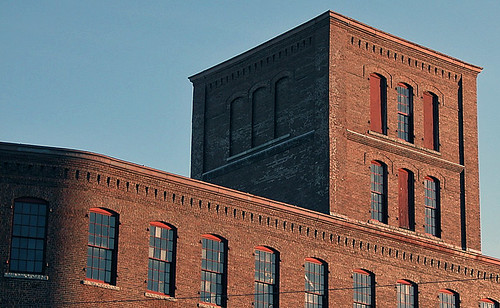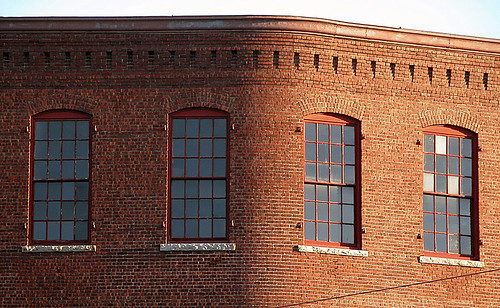North Chelmsford mill building

Tony Sampas ventured into North Chelmsford to take these photos of the mill building near the corner of Middlesex and Foundry Streets. (Can anyone help us with its name?)


Tony Sampas ventured into North Chelmsford to take these photos of the mill building near the corner of Middlesex and Foundry Streets. (Can anyone help us with its name?)

Well, for what it’s worth, Google Books has this to say:
https://books.google.com/books?id=WqZjPTcgpfIC&pg=PA671&lpg=PA671&dq=north+chelmsford+mills+history&source=bl&ots=x0CnEhS2b4&sig=ogcE0HXOguUQSt5WyG8f3RexIh0&hl=en&ei=5gJxTd-mPIHdgQe0yqgm&sa=X&oi=book_result&ct=result&resnum=8&ved=0CFUQ6AEwBw#v=onepage&q=north%20chelmsford%20mills%20history&f=false
“About the year 1900 the principal industries of North Chelmsford were George C Moore’s mills where wool scouring and spinning woolen yarns were employing probably 300 hands the Chelmsford Foundry Co conducting a business in heavy ornamental cast and wrought iron for building purposes employing about 100 hands and the Silver & Gay Machine Shop manufacturing textile machinery such as spinning frames loopers ball winders etc The electric car line connecting the village with Lowell had been in operation five or six years at that time and this connecting link was beginning to make a change in the conditions of life in the village from what it had been for years past for the industries had depended largely upon the local residents for employees The accessibility to the city through the improved means of transportation has caused the village to grow rapidly in manufacturing and residential buildings Within the last sixteen years many changes have taken place in all lines of public activity Moore’s Mills have changed hands and are now called the Silesia Mills of the US Worsted Co The former owner whose name the mills bore George C Moore has erected new mills slightly up stream on the Stony Brook Railroad principally for wool washing and spinning Part of this mill has been occupied for six or seven years by the Lowell Textile Co which manufactures towels ”
https://www.chelmsfordgov.com/CHCwebsite/CHC_files/Map1889North.jpg
This map is a little older, and shows the Moore mill prior to it being sold. The new mills Moore built mentioned in the book I believe are the ones across Princeton Blvd today, which didn’t exist yet and the land is shown as the Sheldon Storehouse. The exact building Tony photographed looks like it didn’t exist yet either, and the map gets confusing because the brook has really been filled in since then and many of the train tracks are gone. But yeah, I’d imagine it’s a US Worsted Co building…but I’m not sure ;-)
SOUTHWELL COMBING MILL
This handsome building had shutters at one time. Although it isn’t that clear in the photos the thing that struck me was how the waning light was just catching the remnants of the hinges on left side.
A new history book is close to publication which will answer most of your questions on the five-story storehouse built by George C Moore in 1896-7 and now owned by Bob McKittrick. The book is called History of Chelmsford 1910-1970 and I hope to have it published by this fall. It covers most of the mills in North Chelmsford.
Originally the Silesia Mills. Sold at a foreclosure auction in 1931 and bought by Sothwell Combing. It was again sold in the 1950’s to FGW McKittrick Company and resold in the 1980’s to Realty Professionals, inc. who is still the owner today. I have original 1931 auction booklet feel free to contact me to get a copy.
This building is currently owned by Realty Professionals. It is constructed of brick walls on a granite foundation with HEAVY timber columns and framing with steel tensioning rods. It has two freight elevators. The stream runs under part of the building. When I was a child, the dam of Crystal Lake failed and washed out the underside of part of the building. My grandfather had the damage rebuilt with reinforced concrete footings, steel girders and rebuilt channel walls under the basement floor. The exterior brick walls are 32 inches thick. The floors are 3″ thick criss crossed diagonal planking, Main columns are 8 feet on center in three rows 28′ apart. Columns are 16 inches square. I ahve not calculated the allowable live load floor loaded yet but an initial guess would be about 500psf.
If Fred Merriam reads this comment and would like to share his info with me, I would be most appreciative. I am currently preparing accurate engineering drawings of the building. You can contact me at 2024 Macopin Road, West Milford, NJ 07480.
My uncle, Frank Cryan, worked there for many years. It is one of the iconic buildings in N. Chelmsford. Beautiful photos, compliments from Italy.